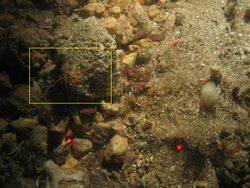Biology:Inachus phalangium
| Inachus phalangium | |
|---|---|

| |
| Scientific classification | |
| Kingdom: | |
| Phylum: | |
| Subphylum: | |
| Class: | |
| Order: | |
| Infraorder: | |
| Family: | |
| Genus: | Inachus
|
| Species: | I. phalangium
|
| Binomial name | |
| Inachus phalangium (Fabricius, 1775)
| |
| Synonyms [1] | |
| |
Inachus phalangium, Leach's spider crab, is a species of crabs from the north-eastern Atlantic Ocean and Mediterranean Sea. It is up to 20.5 mm (0.81 in) wide, and is very similar to other species in the genus Inachus.
Description
Large males may reach a carapace size of 20.5 by 17.5 millimetres (0.8 in × 0.7 in), and is brownish-yellow in colour.[2] The carapace becomes narrower towards the front of the animal, and is often concealed by epibionts.[3] I. phalangium resembles the closely related species Inachus dorsettensis, but has less prominent spines on the carapace.[2]
Distribution
I. phalangium is found in the eastern Atlantic Ocean, from Norway in the north to West Africa and the Cape Verde islands in the south, and extending into the Mediterranean Sea.[2] It lives at depths of 11–55 metres (40–180 ft).[2]
Ecology

Inachus phalangium lives commensally with the sea anemone Anemonia sulcata (snakelocks anemone).[4] The crab gains protection from potential predators by sheltering beneath the anemone's stinging tentacles.[5] The crab eats particles of food dropped by the sea anemone, and mucus from the surface of the anemone.[6]
Taxonomy
The earliest scientific description of Leach's spider crab may have been Carl Linnaeus' description of "Cancer tribulus" in the 12th edition of his Systema Naturae in 1767. Linnaeus' description was, however, too vague to allow the species to be confidently identified.[7] That name is therefore a nomen dubium, and it was suppressed by the International Commission on Zoological Nomenclature in 1964 at the request of Lipke Holthuis.[8] The first valid description was Johan Christian Fabricius' publication of the name Cancer phalangium in his 1775 work Systema Entomologiae. The name Cancer phalangium was later protected by being placed on the Official List of Specific Names in Zoology.[9]
References
- ↑ "Inachus phalangium (Fabricius, 1775)". World Register of Marine Species. 2010. http://www.marinespecies.org/aphia.php?p=taxdetails&id=107333. Retrieved February 18, 2011.
- ↑ 2.0 2.1 2.2 2.3 P. J. Hayward; M. J. Isaac; P. Makings; J. Moyse; E. Naylor; G. Smaldon (1995). "Crustaceans". Handbook of the Marine Fauna of North-west Europe. Oxford University Press. pp. 289–461. ISBN 978-0-19-854055-7. https://books.google.com/books?id=sZ8mdRT4jbIC&pg=PA447.
- ↑ "Inachus phalangium". Macrobenthos of the North Sea: Crustacea. Universiteit van Amsterdam. http://nlbif.eti.uva.nl/bis/crustacea.php?menuentry=soorten&id=200. Retrieved February 18, 2011.
- ↑ Peter Wirtz; Rudolf Diesel (1983). "The social structure of Inachus phalangium, a spider crab associated with the sea anemone Anemonia sulcata". Zeitschrift für Tierpsychologie 62 (3): 209–234. doi:10.1111/j.1439-0310.1983.tb02152.x.
- ↑ Rudolf Diesel (1988). "Male-female association in the spider crab Inachus phalangium: the influence of female reproductive stage and size". Journal of Crustacean Biology 8 (1): 63–69. doi:10.2307/1548431.
- ↑ L. G. Jonsson; T. Lundälv; K. Johannesson (2001). "Symbiotic associations between anthozoans and crustaceans in a temperate coastal area" (PDF). Marine Ecology Progress Series 209: 189–195. doi:10.3354/meps209189. https://www.int-res.com/articles/meps/209/m209p189.pdf.
- ↑ L. B. Holthuis (1962). "Arctopsis Lamarck, 1801 (Crustacea, Decapoda); proposed suppression under the plenary powers, and related matters". Bulletin of Zoological Nomenclature 19 (3): 184–188. https://www.biodiversitylibrary.org/page/12221057.
- ↑ International Commission on Zoological Nomenclature (1964). "Opinion 708. Arctopsis Lamarck, 1801 (Crustacea, Decapida): suppressed under the plenary powers". Bulletin of Zoological Nomenclature 21 (3): 208–209. https://www.biodiversitylibrary.org/page/12222061.
- ↑ International Commission on Zoological Nomenclature (1966). "Opinion 763. Stenorhynchus Lamarck, 1818 (Crustacea, Decapoda): validated under the plenary powers with designation of Cancer seticornis Herbst, 1788, as type-species". Bulletin of Zoological Nomenclature 23 (1): 19–21. https://www.biodiversitylibrary.org/page/12222820.
Further reading
- R. Diesel (1986). "Population dynamics of the commensal spider crab Inachus phalangium (Decapoda: Maiidae)". Marine Biology 91 (4): 481–489. doi:10.1007/BF00392599.
- G. Weinbauer; V. Nussbaumer; R. A. Patzner (1982). "Studies on the relationship between Inachus phalangium Fabricius (Maiidae) and Anemonia sulcata Pennant in their natural environment". Marine Ecology 3 (2): 143–150. doi:10.1111/j.1439-0485.1982.tb00379.x.
- Rocco Rorandelli; Marina Gomei; Marco Vannini; Stefano Cannicci (2007). "Feeding and masking selection in Inachus phalangium (Decapoda, Majidae): dressing up has never been so complicated". Marine Ecology Progress Series 336: 225–233. doi:10.3354/meps336225.
External links
- Photos of Inachus phalangium on Sealife Collection
Wikidata ☰ Q1759963 entry
 |

